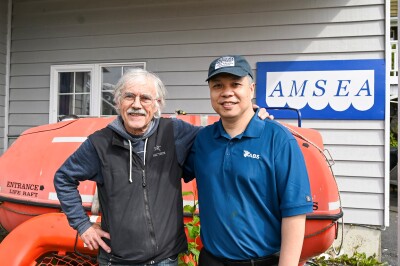A Coast Guard crew conducting routine buoy maintenance on Monday found one of the navigational aids off Block Island, R.I., riddled with bullet holes and partially sunk.
The damage to Clay Head buoy number 7, which marks a large rock 3’ below the water’s surface, was discovered by the crew of Coast Guard cutter Ida Lewis, a 175’ buoy tender homeported in Newport, R.I. The crew raised the 12,000-pound buoy and found 20 bullet holes in it.

A close-up of bullet holes in Clay Head buoy number 7, found submerged off Rhode Island on April 24, 2017. USCG photo by by Chief Warrant Officer 3 Patrick Morkis.
Due to the extensive damage, the buoy was taken out of service for repairs. Situated on a ferry route used for regular deliveries to Block Island, buoy number 7 is a key navigational tool for mariners. It’s also the second buoy discovered with bullet holes in the space of a week, the Coast Guard said.
"While it may be fun to use a buoy for target practice, it is a federal crime," said Senior Chief Petty Officer Timothy Chase, the U.S. Coast Guard officer in charge of aids-to-navigation in the vicinity of Block Island. "Buoy number 7 became a navigational hazard that could have easily been struck by a vessel and seriously injured or killed mariners."
Damaging or tampering with federal aids-to-navigation is a crime and the maximum penalties upon conviction are up to 20 years of imprisonment and as much as $2,500 fine per day for each violation.
Local authorities are seeking information about the crime, and requested that tipsters contact the North Shoreham Police Department at 401-466-3220 or the Coast Guard at 401-435-2351.
While the Coast Guard encourages calls about the latest act of buoy vandalism, the agency is taking steps to crack down on search and rescue hoax callers, a growing problem on the Channel 16 maritime distress frequency.
The Coast Guard has partnered with an academic research team from Carnegie Mellon University that specializes in voice forensics and audio analytics. The partnership is part of a three-pronged approach to tackling the SAR hoax call phenomenon undertaken by the Coast Guard Research and Development Center and the Coast Guard Investigative Service.
The overall project employs enhanced direction-finding equipment and social media monitoring and awareness efforts to identify potential hoax callers, but the audio forensics are the centerpiece of the strategy. In conjunction with R&D Center project managers and CGIS agents, CMU provides voice forensics analysis on sample hoax calls. With this analysis, CGIS agents can potentially glean several key biometric and environmental “cues” for further research and pursuit.
The Coast Guard is also working with media to get the word out about the hoax problem and broadcast the potential fines and punishments levied against serial callers.







